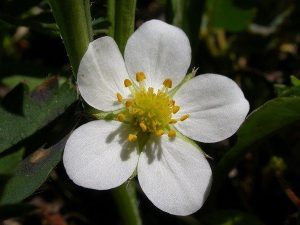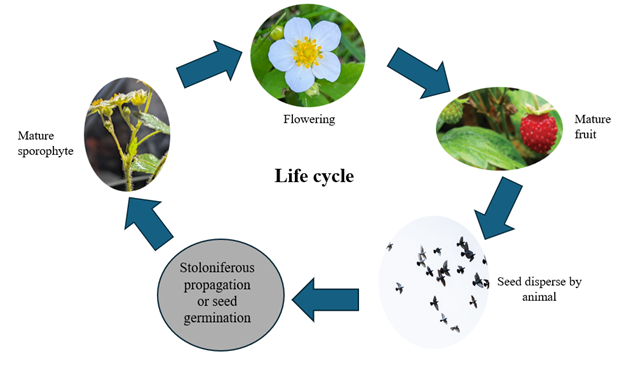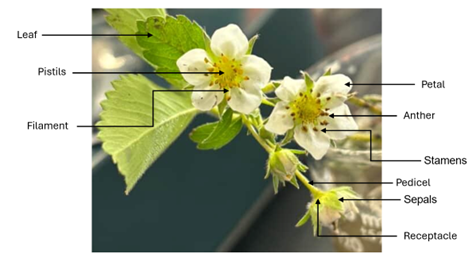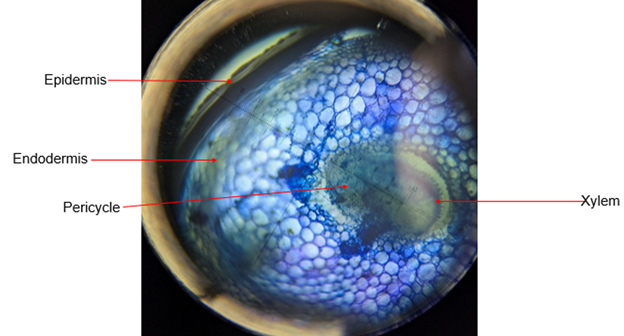1.8 Fragaria Virginiana
Sophie Nguyen
 Fragaria Virginiana
Fragaria Virginiana
Author: Sophie Nguyen
1. Plant Description
Fragaria Virginiana, commonly known as wild strawberry, field Strawberry. This plant is a:
- Perennial: Regrowth after each year
- Eudicot: The plant has two embryonic leaves
- Angiosperm: The plant produces flowers and fruit
- Herbaceous: This plant has no woody stem; it has a soft, green stem
- Root: This plant has a fibrous root system that is thin and spread out from the crown of the plant.
- Monoecious: Each flower contains both stamens and pistils.
2. Identification

Location: This plant is commonly found in fields, meadows, forest edges or slopes (Colorado State University Extension, n.d.).
Flowering: Flowering occurs in late April to early May in SW Ontario. The flower has a radially symmetrical shape, with five petals per flower. The petal has a white colour and each petal has an oval to round shape (Garry Oak Ecosystem Recovery Team, 2025). The flower usually grows in a close cluster on a pedicel (small stem). This flower is perfect because at the centre of it, there are around 20 yellow stamens (male part) and many yellow pistils (female part).
Leaves: The leaves grow in a trifoliate, meaning each leaf is made up of three leaflets. The leaf shape is obovate, which means the base of the leaf is round and then it gets narrower toward the tip of the leaf (North Carolina Extension Gardener Plant Toolbox, n.d.). The upper part of the leaves has a bluish green colour with a smooth surface, and the lower part has a velvety texture because of the hair present on the leaves (Minnesota Wildflowers, n.d.). The margins of the leaves are dentate, meaning they are coarsely toothed on the margins.
Fruit: The fruit is small, round and red with achenes, the little seeds that are on the outside of the fruit. The achenes are embedded in the surface of the fruit, and they are around 1.5 mm long. (Garry Oak Ecosystem Recovery Team, 2025).
3. Cultivation
Soil: Fragaria Virginiana prefers dry and sandy soil in places that are somewhat moist, like grassy edges and hills. (Garry Oak Ecosystem Recovery Team, 2025).
Sun: The plant would grow best in full sun. (Piedmont Master Gardeners, n.d.).
Runner: The plant reproduces by runners, which are stems that resemble roots to form new plants. The runners are often dull red. Since the seed germination of Fragaria Virginiana is poor, these runners are the main way that this plant reproduces. (Deng & Marshall, n.d.).
Ground cover: This plant grows low to the ground and spreads quickly by stolon, so it can slow water erosion.
4. Cultural History
Fragaria Virginiana get its name from the Latin word “fraga” meaning strawberry, and the Virginiana means “of Virginia”. These plants got the common name “strawberry” from their traditional use of being mulched with straw to prevent the onset of fungal diseases. Dysentery was treated with tea made from the dried leaves of this plant (DeLain, 2025).
5. Life Cycle

Flowering: The white flower blooms in early spring; it has both male and female parts for reproduction. The flower contains 20 yellow stamens (male part), which produce pollen and many yellow pistils (female part), which contain ovules in the centre. Inside the anthers, there are pollen grains, which develop from haploid microspores. In the ovules, the female gametophyte was developed from a haploid megaspore.

Mature fruit: The achenes, the little seeds that sit on the surface, are the actual fruit of the plant. They each contain 1 singular seed, and they can germinate in the right conditions to produce a new plant. The red, fleshy part of the plant is the enlarged receptacle, which is the base of the flower. They are small and sweet, and it is produced from around June to July.
Seeds Spread by Animals: The seed can be spread by animals like birds or small mammals. The animal would ingest the fleshy part along with the seed and excrete the seed in a new location. Insects like bees and butterflies would pollinate the flower.
Asexual reproduction: F. Virginiana uses stolon, a horizontal stem that grows along the ground, to produce roots and branches. The new identical plant will grow at nodes along the stolon, helping the plant to cover the ground quickly and survive more efficiently (Encyclopaedia Britannica, 2023).
6. Anatomy and Physiology

Dermal tissue: The protective layer of the stem, root, leaf, flower, fruit, and seed of the plant is the epidermis tissue, which is 1 cell thick. It protects the plant from injury, water loss, and infection. In stems/leaves, stomata allow gas exchange; in roots, the epidermis aids absorption with root hairs (Encyclopaedia Britannica, 2014). In the stem of the plant, the epidermis cells would make cutin, a waxy substance to keep the water from evaporating from the plant. There are no cutin in the root since it needs to soak up water and nutrients. But there is root hair in the root, which is an extension from the epidermis cell wall to increase surface area to absorb more water and nutrients in the soil. The epithermal cell in the leaf has a guard cell that works in pairs, forming an opening that lets the gases in and out called stomata (Michaels et al., 2022).
Vascular tissue : Vascular tissue is the transport system in plants, which helps move water, minerals, and food throughout the plant. There are two main vascular tissues: xylem and phloem. The xylem moves water unidirectionally, from the root to the leaves and then escapes through the stomata. The xylem helps support the stem, and they are mostly made from dead, hollow cells at maturity. The phloem moves nutrients in multiple directions. The nutrients that are moved by this tissue are mostly sugars manufactured by photosynthesis and plant hormones. Unlike xylem, the phloem is made up of living cells.
Mesophyll: The mesophyll is located between the lower and upper outer layers of the epidermis. The mesophyll is the part where most photosynthesis happens. The mesophyll has two layers: the palisade mesophyll and the spongy mesophyll. The palisade mesophyll contains tightly packed cells that are full of chloroplasts, which help the plant to do photosynthesis. The spongy mesophyll has many cells that contain air spaces, which allow gases like carbon dioxide and oxygen to move inside the leaf easily. Wild strawberries were tested to grow under different light conditions, bright light or low light. This experiment shows that the leaves grown in bright light were thicker and had more mesophyll compared to leaves grown in low light (Jurik et al, 1982). This proves that this plant grows better in full sun rather than in shady areas.
7. Summary
Wild strawberry is an easy plant that anyone can plant in their garden. It produces amazing red “fruit” and helps the pollinator.
References
Colorado State University Extension. (n.d.). Fragaria virginiana (wild strawberry). Colorado Plant Database. https://coloradoplants.jeffco.us/plant/details/450
DeLain, B. (2025). Wild strawberry (Fragaria virginiana). Johnson’s Nursery Knowledgebase. https://kb.jniplants.com/wild-strawberry-fragaria-virginiana
Deng, W., & Marshall, C. (n.d.). Fragaria virginiana (wild strawberry) (Rosaceae). Lake Forest College. https://www.lakeforest.edu/academics/majors-and-minors/environmental-studies/fragaria-virginiana-(wild-strawberry)-rosaceae
Encyclopaedia Britannica. (2014, November 25). Epidermis. Encyclopaedia Britannica. https://www.britannica.com/science/epidermis-plant-tissue
Encyclopaedia Britannica. (2023, March 6). Stolon. Encyclopaedia Britannica. https://www.britannica.com/science/stolon-biology
Garry Oak Ecosystems Recovery Team. (2025, June 18). Wild strawberry (Fragaria virginiana). https://goert.ca/species/fragaria-virginiana/
Jurik, T. W., Chabot, J. F., & Chabot, B. F. (1982). Effects of light and nutrients on leaf size, CO₂ exchange, and anatomy in wild strawberry (Fragaria virginiana). Plant Physiology, 70(4), 1044–1048. https://doi.org/10.1104/pp.70.4.1044
Michaels, T., Clark, M., Hoover, E., Irish, L., Smith, A., & Tepe, E. (2022, July 27). 6.1: Plant cells and tissues. Biology LibreTexts. https://bio.libretexts.org/Bookshelves/Botany/The_Science_of_Plants_-_Understanding_Plants_and_How_They_Grow_(Michaels_et_al.)/06%3A_Cells_Tissues_and_Woody_Growth/6.01%3A_Plant_Cells_and_Tissues
Minnesota Wildflowers. (n.d.). Fragaria virginiana (wild strawberry). https://minnesotawildflowers.info/flower/wild-strawberry
North Carolina Extension Gardener Plant Toolbox. (n.d.). Fragaria virginiana (wild strawberry). NC State Extension. https://plants.ces.ncsu.edu/plants/fragaria-virginiana/
Piedmont Master Gardeners. (n.d.). Strawberry basics for the home garden. https://piedmontmastergardeners.org/article/strawberry-basics-for-the-home-garden/

